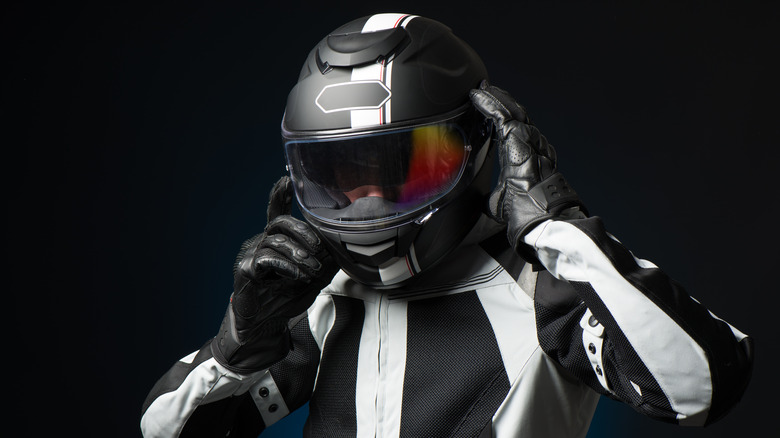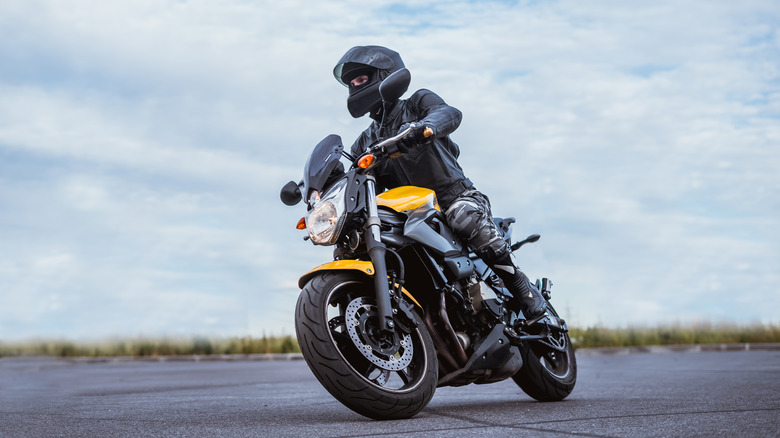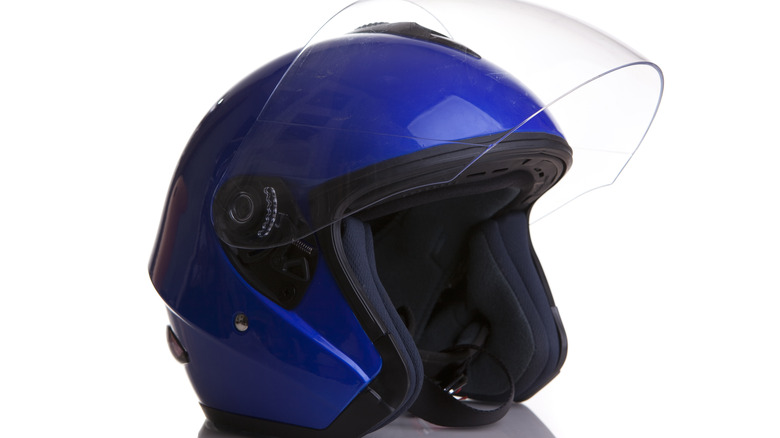5 Things To Look For When Buying A New Motorcycle Helmet
Freedom, adventure, and efficiency are just a few of the words that come to mind when we think of motorcycles. While many view motorcycles as the ultimate symbol of personal expression and liberation, they also demand respect for safety and responsible riding. When you get on a bike, you're much more exposed than when driving or using other modes of transportation, making the right protective gear a must. That's where helmets come in; they reduce the risk of death and injury if you ever get into an accident and protect your most important body part — the brain.
There's no purchase more important than a helmet for a motorcyclist. They're also a legal requirement for all riders in 18 states and the District of Columbia. From head-turning smart helmets to modular and flip-up designs, there are all types of helmets on the market. While it may be tempting to pick up the first helmet that catches your eye, taking the time to properly evaluate a helmet before you buy is a must to ensure you get the best protection and experience on the road.
Safety Certifications
While there are a lot of myths about motorcycles, including motorcycle helmets, the importance of safety cannot be overstated when it comes to choosing a motorcycle helmet. Before you do anything else, you'll want to check to see if the helmet you're considering meets recognized safety requirements. The safety ratings you see on a helmet will depend on where you're located in the world. In the U.S., look for the Department of Transportation (DOT) rating, FMVSS No. 218 Certified, on the back of the helmet. While DOT relies on a self-certification process, they conduct random tests to verify compliance and adherence to safety standards.
The European Commission for Europe (ECE) is another key safety rating that is recognized in more than 50 countries. The ECE standard is generally considered stricter than the DOT standard and includes testing impact absorption, penetration resistance, strap system strength, field of vision, and even testing for abrasion resistance. Unlike DOT, the ECE requires batch testing before helmets are approved for sale. While the ECE and DOT standards are different, both ensure a high level of safety for motorcycle helmets.
Proper Fit and Comfort
Once you've confirmed the helmet you're thinking about buying has the proper safety certifications, it's time to turn your attention to how well the helmet fits and how comfortable it is to wear. You'll be spending a lot of hours riding in this helmet, and you want to feel good while doing so. A good fit is also a critical safety component. If your helmet is too big and comes off in a crash, it won't do you much good, no matter how many safety ratings it has.
That's why you want to choose a helmet with a tight, snug fit. You want to ensure it sits squarely on your head with the top of the helmet's eye port just above your eyebrows. The cheek pads should fit snugly against the cheeks without causing you discomfort, and you should be able to easily adjust the chin strap for a secure fit under your chin. If the helmet shifts or slides easily while you're wearing it, it's probably too big.
Material and Build Quality
When shopping for a helmet, pay attention to the material and build quality. If you do your homework and ensure the helmet you choose is certified by DOT, ECE, or another competent body, you won't have to worry about unsafe materials. However, the materials used to make a helmet can significantly impact a helmet's weight, performance, and effectiveness. It also affects a helmet's durability and how well it withstands wear and tear over time. If you get into an accident, the material will play a critical role in absorbing and dissipating the energy from an impact.
Polycarbonate, fiberglass composite, and carbon fiber are the materials most commonly used to make motorcycle helmets. Polycarbonate is the most cost-effective material and is known for its flexibility and ability to absorb energy on impact. While it's an affordable option, it may be slightly heavier than helmets made from more advanced materials. Helmets made from fiberglass composite tend to be lighter than polycarbonate helmets and can spread the force of an impact more effectively. Carbon fiber helmets are known for their strength and lightness; they provide the best protection and distribute impact force evenly throughout the helmet to help keep you safe in an accident.
Visibility
Whether you're out riding on the open road or stuck in traffic on a busy highway, visibility plays a significant role in keeping you safe. Good visibility in a helmet is crucial for two reasons: it allows the rider to clearly see their surroundings and also makes them more visible to other road users. The helmet's visor is the first thing you should look at when judging its visibility. The visor's primary function is to ensure you have a clear vision during various riding conditions. It should have anti-fog features to prevent it from fogging up and blocking your view.
You'll also want to be sure the helmet doesn't negatively impact your peripheral vision. A helmet should allow you to see as much of your surroundings as possible without needing to strain or turn your head excessively so you can maneuver through traffic safely. Being sure other drivers can see you is just as important as being able to see them, making it important to choose a helmet with bright or reflective colors to enhance your visibility, especially in low-light conditions.
Ventilation
A helmet with good ventilation will help keep you cool when it's hot outside and prevent the visor from fogging up, keeping you comfortable on long rides and ensuring you have a clear view of the road. This is particularly important in warmer climates and during summer, as it allows air to flow freely and reduces heat and moisture buildup inside the helmet. You'll also breathe easier with a well-ventilated helmet. All of this goes a long way towards allowing you to maintain your focus on the road, something that's important for safe riding during long journeys or in harsh conditions.
Proper ventilation also plays an important role in a rider's hygiene and comfort by minimizing sweat accumulation, unpleasant odors, and bacteria inside the helmet. Motorcycle helmets are available with a variety of ventilation systems, including adjustable air vents, chin bar vents, top vents, and rear exhaust vents. Some advanced helmets come with sophisticated integrated systems that optimize airflow throughout the helmet.





